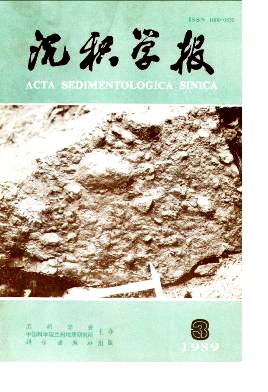Zhu Jiaxiang, Li Shuzben. DIAGENETIC MECHANISM OF MINERALS AND POROSITY IN SANDSTONE OF THE LOWER I)AINAN FORMATION,IN THE GAOYOU SUB-DEPRESSION,THE NORTH JIANGSU BASIN[J]. Acta Sedimentologica Sinica, 1989, 7(3): 39-51.
| Citation:
|
Zhu Jiaxiang, Li Shuzben. DIAGENETIC MECHANISM OF MINERALS AND POROSITY IN SANDSTONE OF THE LOWER I)AINAN FORMATION,IN THE GAOYOU SUB-DEPRESSION,THE NORTH JIANGSU BASIN[J]. Acta Sedimentologica Sinica, 1989, 7(3): 39-51.
|
DIAGENETIC MECHANISM OF MINERALS AND POROSITY IN SANDSTONE OF THE LOWER I)AINAN FORMATION,IN THE GAOYOU SUB-DEPRESSION,THE NORTH JIANGSU BASIN
- Received Date: 1987-04-07
- Publish Date:
1989-09-10
-
Abstract
The Lower Dainan Formation, Early Tertiary,of the Gaoyou Sub- Depression in the north Jiangsu Basin is a main oi-lbearing reservoirs, with the maximum thickness of more 800m in the central part of the basin. Core sample was systematically made from 22 wells in different depths from the west margin accross the studies area eastwards. Eased on detailed analysis of minerology, geochemistry, and rock physical properties. using the methods of thin section. SEM, pore casts, kerogen. and vitrinite retlectane, etc,the burial diagenetic chacteristics of sandstones are discussed. With burial deeping, the grains of quartz and feldspar and minor heavy minerals were dissolved, overgrown, pressuredissolved and replaced or altered. Carbonate cements occurred dissolution and replacment, and formed two different diagenctic mineral sertes in the shallower and deeper depths. According to constituent, aggregation, series of minerals in grain and cement. and properties and types of porosity, four distinct diagenetic zones can be divided:immature, low mature, mature I and mature II. Sandstone reservoirs have primary and secondary porosities, which control the distribution of physical parameters in the shallower and deeper reservoirs. respectively. In the shallower reservoir predomnantes primary porosity where occurred less dissolved secondary porosity relatively. With the increase of machanical compaction and chemical precipitation, the total porosity decrease gradually. The peak of carbonate precipitation occurred at 2800 m and form a high carbonatizicd sandstone zone and sametime the porosity tended to diminish. Helow the carbonatizied sandstone zone the secondary porosity became predominance with total porosity increase. The dissolution of silicates, carbonates and other salts is a major factor in generation of secondary porosity. Two important conditions of mineral dissolution are pIi of pore water and temperature. Twenty patterns of secondary porosity show aregular evolution of dissolution in various diagenetic environments. In the different depths two intensive secondary porosity zouec occurred caused by different origins.The first intensive secondary porosity gone ranges from 2950 to 3150 m in depth. and the face pore dcnsity can reach about 14%,which just coincides with the high vale ranges of radio of pristane over phy tape. hydrocarbon over organic carbon. It suggests that occurrence and development of the first intensive secon dary porosity zone is related to dcearboxylation and organic acids ieicase of kerogcn Crom associated mudstones during the early organic mature stage. Hy theoretical calculation, about 1.7-4.6% of new porosity could form by the dissolution of feldspar and carbonate resulting only from decarboxylation. This zone is a principal place of hydrocarbon primary migration and accumulates mainly low mature oil. The second intensive secondary porosity zone occurred from 3300 to 3650 m, with face pore density reaching about 16%.Its origin is closely related to the specific replacement reaction between feldspars,silica and dolomites. By theoretical calculation, These two reactions could produced C0168034g and 544278 and caused new dissolved porosity about 7.7% by dissolution of feldspars and calcites. The second intensive secondary porosity zone caused by inorganic reactions within the sandstoncs could accumulate high mature oil or condensates. which should be a potential site for oil and gas exploration in the deep depth.
-
References
|
[1]
|
朱国华,1982,石油与天然气地质,3卷3期,159-203页. |
|
[2]
|
恩格尔哈特,1982,沉积岩石学(III )沉积物和沉积岩的成因.地质出版社. |
|
[3]
|
Hutcheon. I, Oldershaw, A.,Ghent. E. D.,1980, Geochim.Cosmochim. Acta.V,44, p.1425-1435. |
|
[4]
|
Lundegard. P. D..and Land, L. S.,1986, SEPM. special publication, N.38,p.129-145. |
|
[5]
|
Meshri, LD.1986, SEPM. special publication. N.38. p.123-128 |
|
[6]
|
Schmidt. V. and McDonald, D.A., 1979, SEPM. special publication, N.26. p.175-207. |
|
[7]
|
Schmidt. V.and McDonald. D. A.,1979. SEPM. special publication. N.26.p.209-225. |
|
[8]
|
Scholle. P.A., 1979, AAPG. Memoir 28, p.93-181. |
|
[9]
|
Shanmugam. G., 1985. Bull. AAPG, V.69. N.3, p.378-384. |
|
[10]
|
Sommer. F., 1978, Jour. Geol. Soc. London. V.135, p.63-67. |
-
-
Proportional views

-






 DownLoad:
DownLoad: